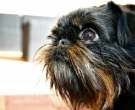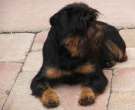Content |
|---|
History
Originally from Belgium, as the name reflects, the Griffon belge It is an original and easy-going companion dog.. Rational in origin, They are today friendly and lively companions who however struggle to find their audience as they remain one of the lesser known breeds in the group. 9.
The three races that make up the group 9 of the ICF have a similar morphology, but different coat quality and color varieties.
They share a common history and are descended from a small, wire-haired dog., the “smousje“, present in the Brussels region for decades.
The three varieties were selected in the 19th century with blood from other small companion breeds such as the Pug and the Cavalier King Charles spaniel. The Yorkshire Terrier, the Miniature Schnauzer and the Affenpinscher they could also have been used in the cocktail that created the three races.
The first Griffon belge were entered in the Book of Origins of Saint-Hubert in 1883.
These dogs became very popular at the beginning of the 20th century thanks to the interest shown by Queen Marie Henriette of Belgium.. They became the favorites of high society ladies and elegant women.
The iconography that represents the breed is abundant and paintings with small wire-haired Griffons have been found since the 17th century..
The breed began to be exported abroad, especially to France in the middle of the 20th century.
Physical characteristics
This is a small dog a balanced, sturdy built, almost square body frame, fixed frame and elegant movements, the look awake and lively. Its almost human expression is especially striking.
The body weight is about 3,5 – 6 kg. The head is the most characteristic and striking part of the body. It must be quite large compared to the body and the hair of it is rough, erected, makes a rich mustache and beard. It also highlights the visual aspect of the “big head”. The skull should be broad and rounded, properly arched eyebrows.
The nose from the front at the same level as the eyes should be black, wide, with the nostrils properly open. Its tip should be so far back when viewed from the side flush with chin and forehead.
The lips are black at the edges, tight, near the jaws and teeth. There is no overlap of the top and bottom. If they are too loose, interrupt the desired expression. The lower jaw is longer than the upper jaw (physiologically underprotected jaw), directed slightly upwards, wide at the top and cannot be pointed. Its width is very important since the chin protrudes. The incisors of both jaws should be regularly arranged in a row, in which the top and bottom are parallel. No incisors should be missing. If the mouth is closed, neither teeth nor tongue can be seen.
The eyes must be separated, be big and round, should never be prominent. The iris is brown, the more dark best. The edges of the eyelids should be black. The defect is considered small eyes, oval in shape and bright colors.
The back is straight, short and strong. The tail must be set high and carried. When amputated, should be reduced by 2/3 of its original length. If the animal protection law prohibits cuts, can remain uncut. When it unfolds, must be high, curved so that its tip bends towards the back, don't touch the back or can't squirm. Short tail, twisted or kinked is considered a serious offense.
The Griffon belge they have a rough coat with undercoat. The mantle is rough, slightly wavy, but not curly. The fur rules, but to be correctly evaluated its structure must be long enough. Too long hair obscures the typical silhouette and is therefore not acceptable. A silky or woolly coat is evaluated as a serious fault.
Character and skills
He is a nervous dog and can become a very barking dog if he feels lonely or bored. He has a strong personality and for this he needs a good education from a very young age. The Griffon belge she is also lively, attentive, brave and always act with determination. So, You have to be careful that he does not suffer because his courage and self-confidence often means that he does not see the danger.
Can usually live with children and other pets. A curious and loving dog of character Terrier, very active and always reacts to strange noises.
The Griffon belge needs to be accompanied all the time, cannot stand being alone and may develop negative behaviors to attract attention such as barking or causing damage. This “hairy” has a tendency to become attached to a person, following her most of the time.
Tireless and always ready to play with everyone, he's kind most of the time, but you can also play a role of guardian of the property and your family.
Education
He is very intelligent and loves to learn. Your education is, Therefore, relatively easy, although it must be firm and adequate, as she tends to be slightly stubborn at times.
An early and well-adapted education will prevent him from growing up doing only what he wants.
Very sociable, has no problem with the inhabitants of the house, whether human or animal.
Although he is sociable by nature, sometimes he is shy with strangers, which makes him a good guardian. So, their socialization should be aimed at not exacerbating this natural shyness in front of strangers.
They can live anywhere and with any type of owner. Despite its small size, have a great need for exercise, but it is easy for him to do it anywhere, precisely because of its small size.
Health
The Griffon belge is generally in excellent health. They are not affected by any particular disease or pathology.
Some subjects may sometimes suffer from eye infections or dermatological problems, although these cases are still rare. Its longevity is very appreciable.
Grooming
Her pretty fur, quite complete, requires regular brushing to ensure a beautiful and healthy coat. No other particular maintenance is necessary.
Utility
They are great companions, besides being incredible guard and hunting dogs. They can easily raise the alarm when intruders invade their territory, as well as scare away small rodents from the area. It is also very noticeable in skill sports (agility).
Price
Purchase price of a puppy Griffon belge: between 700 € y 900 €.
Characteristics "Griffon belge"
Coexistence is important that you have with your new friend. Before considering the acquisition of a dog of the breed "Griffon belge" you know certain factors. Not all breeds of dogs are apt to live in an apartment, you must take into account his character, their need for exercise, their interaction with other pets, their care and if you have small children, their level of tolerance towards them.
Adaptation ⓘ2.0 out of 5 stars (based on 1 review)
|
friendly dog ⓘ3.0 out of 5 stars (based on 1 review)
|
hair loss ⓘ1.0 out of 5 stars (based on 1 review)
|
|---|---|---|
Affection level ⓘ4.0 out of 5 stars (based on 1 review)
|
Need for exercise ⓘ3.0 out of 5 stars (based on 1 review)
|
Social need ⓘ3.0 out of 5 stars (based on 1 review)
|
Home ⓘ3.0 out of 5 stars (based on 1 review)
|
Toilet ⓘ3.0 out of 5 stars (based on 1 review)
|
Friendly with strangers ⓘ2.0 out of 5 stars (based on 1 review)
|
barking ⓘ3.0 out of 5 stars (based on 1 review)
|
Health ⓘ3.0 out of 5 stars (based on 1 review)
|
Territorial ⓘ4.0 out of 5 stars (based on 1 review)
|
Cat friendly ⓘ4.0 out of 5 stars (based on 1 review)
|
Intelligence ⓘ3.0 out of 5 stars (based on 1 review)
|
Versatility ⓘ3.0 out of 5 stars (based on 1 review)
|
Child friendly ⓘ2.0 out of 5 stars (based on 1 review)
|
Surveillance ⓘ2.0 out of 5 stars (based on 1 review)
|
joy ⓘ4.0 out of 5 stars (based on 1 review)
|
Images "Griffon belge"
Photos:
1 – “Griffon belge” by Ger Dekker, CC BY-SA 2.0, via Wikimedia Commons
2 – “Griffon belge” by Ger Dekker, CC BY-SA 2.0, via Wikimedia Commons
3 – “Griffon belge” puppy by Ger Dekker, CC BY-SA 2.0, via Wikimedia Commons
4 – “Griffon belge” by Ger Dekker, CC BY-SA 2.0, via Wikimedia Commons
5 – “Griffon belge” by Ger Dekker
6 – “Griffon belge” by Ger Dekker
Videos "Griffon belge"
Type and recognitions:
- FCI CLASSIFICATION: 81
- Group 9: Companion and Toy Dogs
- Section 3.1: Small Belgian Dogs / Griffons. Without working trial..
Federations:
- FCI – Groupo 9 – Section 3.1 “Griffons” ⓘ
- UKC – Company ⓘ
FCI breed standard "Griffon belge"
Alternative names:
1. Belgium Griffon (English).
2. Griffon belge (French).
3. Griffon Belge (German).
4. Griffon belge (Portuguese).
5. Griffon belge (español).







 Belgian Griffon (Griffon Belge)
Belgian Griffon (Griffon Belge) Vekara Agility , S3 , G , belgian griffin , Mocca
Vekara Agility , S3 , G , belgian griffin , Mocca Belgian Griffon à 6 weeks ( Brussels Griffon )
Belgian Griffon à 6 weeks ( Brussels Griffon ) Grifon Belga – Breed of dog
Grifon Belga – Breed of dog